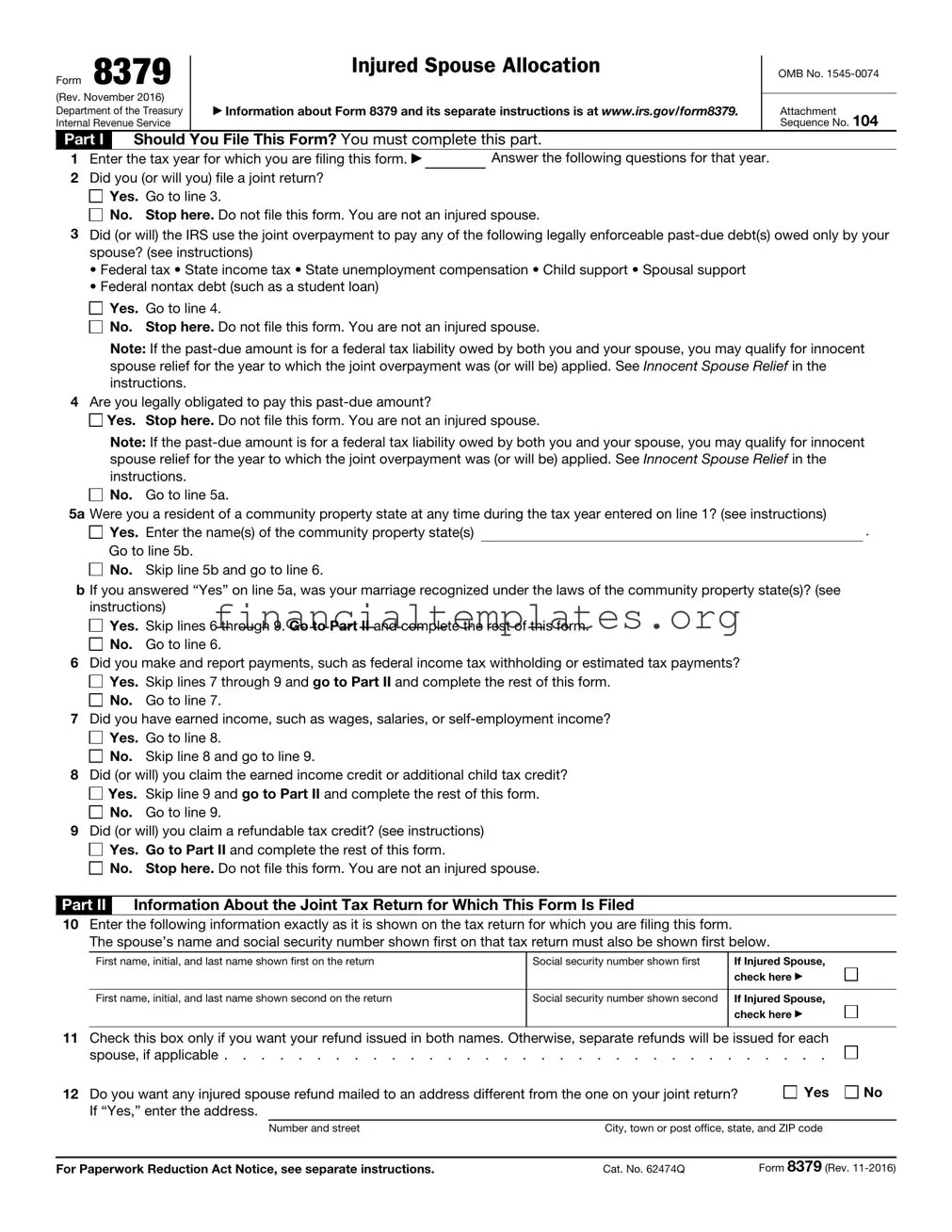The IRS Form 8379, Injured Spouse Allocation, resembles the IRS Form 8857, Request for Innocent Spouse Relief, in several ways. Both forms are designed for spouses seeking relief from joint tax liabilities. While the Form 8379 is for those wanting to prevent their portion of a refund from being applied to their spouse's debts, Form 8857 is used when seeking relief from tax owed due to incorrect items reported by a spouse or ex-spouse. Each form addresses the issue of fairness for individuals who believe they should not be held responsible for their partner's debt.
Similar to IRS Form 8379, Form 1040X, Amended U.S. Individual Income Tax Return, also involves modifying previously filed tax information. Taxpayers use Form 1040X to correct errors or make changes to an original tax return. Although the purposes differ—Form 8379 is for claiming a share of a refund, while Form 1040X is for correcting errors—both forms allow taxpayers to adjust financial representations made to the IRS.
The IRS Form 433-A, Collection Information Statement for Wage Earners and Self-Employed Individuals, shares similarities with Form 8379 in its personal financial disclosure requirements. Form 433-A is used to gather financial information from individuals to establish payment plans or settlements for outstanding taxes. Like Form 8379, it requires detailed personal financial information to assess the filer's economic situation, albeit for different ends: resolution of debt versus allocation of a refund.
IRS Form 656, Offer in Compromise, and Form 8379 are alike in that they both provide means to mitigate financial burdens associated with taxes. Form 656 allows taxpayers to settle their tax liabilities for less than the full amount owed, appealing to those unable to pay their tax debt in full. In contrast, Form 8379 helps ensure that one spouse's portion of a joint refund is not used to cover the other spouse's debts, yet both forms aim to alleviate financial stress related to taxes.
Form 9465, Installment Agreement Request, parallels Form 8379 in its approach to resolving tax-related financial issues. Taxpayers file Form 9465 to request a payment plan for taxes they cannot pay in full by the due date. Although serving different functions—Form 9465 for managing payment of existing tax liabilities, and Form 8379 for protecting a spouse's share of a refund—they both facilitate taxpayers' financial management within the framework of tax obligations.
The resemblance between IRS Form 8379 and the Change of Address Form 8822 lies in their potential to affect the processing of tax documents and disbursements. Form 8822 is used to notify the IRS of a change in address, ensuring that taxpayers receive all correspondence and refunds. Like Form 8379, which seeks to allocate a refund correctly between spouses, ensuring the right party receives the intended funds relies on current personal information being accurately recorded with the IRS.
IRS Form 2848, Power of Attorney and Declaration of Representative, although used for different purposes, shares a procedural similarity with Form 8379. Form 2848 allows taxpayers to authorize an individual to represent them before the IRS, handling tax matters on their behalf. This delegation can include dealing with refunds and debts, areas where Form 8379 may also come into play. Both forms involve authorizing actions related to an individual’s tax responsibilities.
Lastly, IRS Form W-7, Application for IRS Individual Taxpayer Identification Number (ITIN), aligns with Form 8379 in the aspect of taxpayer identification. Form W-7 is utilized by individuals requiring an ITIN to comply with U.S. tax laws. Though its primary purpose is to assign identification numbers, and Form 8379's is to distribute refund portions, both are integral in ensuring accurate processing and allocation of tax responsibilities. Each form, in its way, supports the proper administration of tax laws to benefit the individual taxpayer.




